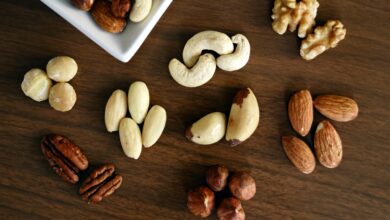
Green tea is a tea renowned for its many benefits and medicinal properties.
In this article, discover everything you need to know about green tea, the benefits of its preparation and the various researches carried out on it.
Description of green tea
Green tea contains caffeine and many antioxidant substances from the catechin family, the main one being EGCG (epigallocatechin gallate).
A dehydrated green tea leaf contains 0.5% to 10% caffeine and 15% to 30% catechins, including 50% to 75% EGCG.
Theanine, what is it?
Theanine is another active ingredient in tea of interest to researchers, as preliminary studies have shown it to have a relaxing effect on the nervous system and a stimulating effect on the immune system.
Several theanine supplements are available on the market, but there is still insufficient data to conclude on its effectiveness.
What’s in a cup of green tea?
A cup of green tea (250 ml), corresponding to the infusion of approximately 2.5 g of tea leaves, contains 50 mg to 150 mg of total catechins and 30 mg to 50 mg of caffeine, i.e. 4 6 times less than 1 cup of filter coffee.
The concentration of EGCG varies from one tea to another, but it can be estimated that it represents on average 60% of the total catechins.
Green tea, because it is less oxidized, is richer in catechins. It contains up to 30%, while black tea only contains about 9%.
The antioxidant properties of green tea are therefore superior to those of black tea.
There are green tea extracts on the market sold in the form of tablets or capsules. Their green tea content is extremely variable, from 100 mg to 750 mg per tablet.
It is therefore important to check the content of total catechins or EGCG, as well as caffeine of the tea you choose.
Indications of green tea
| Efficiency level | Benefits |
| Likely effectiveness | reduction in cholesterol levels;treatment of condyloma (genital warts);prevention of cognitive disorders |
| Possible efficiency | weight reduction (in addition to a change in diet). |
| Uncertain effectiveness | prevention of certain cancers;reduction of hypertension. |
| Traditional use | treat digestive disorders;stimulate cognitive functions;promote the elimination of urine;stimulates blood circulation;accelerates the elimination of alcohol and other toxins. |
Green tea dosage
Reduction of cholesterol level
Green tea extracts
Beneficial results have been obtained with daily doses of 1200 mg to 2300 mg of green tea extract or 491 mg to 714 mg of catechins.
Cancer prevention
Green tea infusion
Three cups of tea a day have a protective effect against certain cancers. The effect would increase with the amount of tea consumed, which can go up to 10 cups per day.
| Warning : the consumption of more than 500 mg of caffeine per day can cause serious side effects in some people (see the complete fact sheet on caffeine ). |
What are the benefits of green tea?
Among the different colors of tea, green tea is the one with the most therapeutic virtues.
Green tea contains caffeine, many antioxidant substances, but also an active ingredient called theanine. It would have a relaxing effect on the nervous system and stimulating on the immune system.
The use of green tea would help to:
- reduce cholesterol levels;
- maintaining good memory and attention;
- promote blood circulation.
Consult your doctor before starting a cure of green tea, since the appropriate dosage varies according to the pain to be relieved.
Pregnant or breastfeeding women, people with liver problems or with an iron deficiency must consult a doctor.
Interactions with green tea
With plants or supplements
Green tea may reduce the absorption of iron taken as a supplement. Additionally, it may increase the risk of liver damage if taken in conjunction with herbs that may cause liver damage (borage).
Green tea would increase the risk of bleeding if taken in parallel with plants likely to reduce blood clotting (ginkgo biloba, Panax ginseng).
With medication
Green tea contains a significant amount of vitamin K. Consumed in large quantities, it could oppose the effects of Warfarin (Coumadin).
Green tea could limit the absorption of folic acid.The caffeine in tea can interact with:
- antidepressant medicines containing monoamine oxidase inhibitors;
- medication prescribed for asthma (risk of cardiac stimulation);
- estrogen, which slows caffeine metabolism;
- psychostimulants (amphetamines, cocaine, ephedrine): significant risk of increased heart rate and blood pressure.
History of green tea
The oldest mention of tea that we know dates from the VIII? century before our era. It is found in a Chinese work, the Book of Songs.
First reserved for dignitaries, tea only really became popular during the Tang Dynasty, around the 8th? century of our era. It is known to have stimulating virtues and a treatise on its cultivation and preparation is dedicated to it.
The tea is then exported from China to its neighbours, Tibet and Mongolia. Then its use spread gradually in the world starting with Japan in the IX? century, under the influence of Buddhist monks.
It is at the beginning of the XVII? century, thanks to the Dutch merchant navy, that Europe discovered tea. It spreads in Holland, Italy, Germany, Portugal, and finally in England where it knows an extraordinary enthusiasm. So much so that an almost official daily break was devoted to its tasting in the 1800s, the five o’clock tea .
In the course of the XIX? century, the British will seize the secret of tea culture and establish it in India, in the Darjeeling region, in Sri Lanka and, later, in West Africa, in Kenya. They will also develop a manufacturing process producing a highly oxidized tea, black tea, and become the world’s leading tea exporters.
Today, tea is the most consumed beverage in the world after water. Green tea represents 18% of global tea consumption and black tea 80%. China remains the leading producing country, followed by India and Kenya.
Green tea research
Treatment of condyloma (genital warts)
In 2006, the American health agency “Food and Drug Administration (FDA)” approved the use of an ointment based on green tea extract for the local treatment of condyloma acuminata.
The ointment in question, Veregen®, contains 15% green tea catechins.
Tested on people suffering from anal and genital warts, it made the warts disappear or regress in about half of the cases. It also prevented their reappearance in a few cases.
This product is available in France at a lower dose (10%) for the same use. However, the high authority of health, the French health agency, indicates that Veregen® 10% is more effective than a placebo, but considers that the beneficial effect is weak.
Reduction of cholesterol level
In 2008, a meta-analysis concluded that the only significant effect of green tea on cardiovascular disease risk factors was the reduction in “bad cholesterol” (LDL) levels. Since then, several clinical studies have obtained results in this direction.
In 2011, two studies indicate that green tea catechins, which are the main polyphenols (or antioxidants) present in the beverage, reduce cholesterol and LDL-cholesterol levels after 6 months in patients suffering from hyperlipidemia, compared to control subjects.
The doses in the studies ranged from 1200 mg to 2300 mg of green tea extract or 491 mg to 3000 mg of tea catechins per day. It should be noted that lower doses do not seem to have an effect on cholesterol levels.
Another clinical study reports that green tea or its catechins reduce “bad cholesterol” (LDL cholesterol), as well as total cholesterol and triglycerides. However, many others come to the conclusion that they have no effect in this area.
memory and attention
Drinking green tea daily appears to help maintain mental alertness and cognitive performance.
In addition, taking a green tea extract with L-theanine seems to improve memory and attention after 4 months in people with mild mental problems.
In 2015, Japanese researchers showed that daily consumption of green tea (1 to 6 cups per day or per week) was associated with a lower risk of dementia or mild cognitive impairment. Thus, the incidence of dementia, including Alzheimer’s disease, was about 4 times lower in those who drink green tea daily, compared to those who do not drink it.
A more moderate consumption (from 1 to 6 times per week) also has a protective effect, although less pronounced.
This work is in line with that reported in 2014 and which showed that a green tea extract (27.5 g) seemed to improve the working memory of participants (N=12; average age = 24 years) by promoting connections between neurons (connections called synapses), compared to those who didn’t drink it.
In addition, an epidemiological study of a thousand Japanese aged at least 70 indicated that those who drank a cup of green tea a day (or 4 to 6 cups a week) had a reduced risk (-38%) of develop cognitive impairment (especially memory problems), compared to those who drank less than three per week.
The risk of cognitive disorders is reduced by two (54%) when consumption is at least two cups per day.
Epigallocathechin gallate (EGCG, the main antioxidant found in green tea), does not appear to improve cognitive performance in healthy adults at daily doses of 135 and 270 mg.
However, EGCG stimulates blood circulation in the brain.
Weight reduction
According to a meta-analysis published in 2010, green tea, more specifically the catechins and caffeine it contains, could have a slimming effect and help control weight, provided it is associated with a suitable diet.
Thus, in people suffering from obesity, daily consumption of green tea extract containing 580 mg to 710 mg of catechins and 40 mg to 110 mg of caffeine led to a reduction in body mass index (BMI ), weight and waist circumference.
If the effect is significant, it remains modest and requires the combination of the two substances (catechins and caffeine).
On the other hand, studies have shown that taking green tea extract increases energy expenditure and stimulates the breakdown of fat stored in the body, effects that could contribute to weight loss.
Green tea and the prevention of certain cancers
The potential role of green tea in cancer prevention is attracting great interest in the scientific community. This interest was first motivated by epidemiological studies suggesting an association between the consumption of green tea and the prevention of certain types of cancer.
Prevention of certain cancers
Later, studies in animal models showed that catechins in tea inhibited the growth of cancerous cells in organs like the breast, lung, esophagus, prostate, liver, and skin. However, there are still few clinical studies that can corroborate the effects of green tea in humans.
In 2005, following a request for a claim concerning the anticancer properties of green tea, the United States Food and Drug Administration (FDA) indicated that there was no scientific evidence of an effect of green tea on following cancers: colon, rectum, stomach, lung, pancreas, and ovaries.
For breast and prostate cancers, the FDA came to the conclusion that its preventive effect is very unlikely.
endometrial cancer
In 2009, a meta-analysis of epidemiological studies showed a correlation between the consumption of green tea and the reduction in the risk of endometrial cancer.
However, the authors of this study draw attention to the fact that the number of studies on the subject is low and that the quantity of green tea used is difficult to quantify.
Another study published the same year went in the same direction by reporting an association between the consumption of green tea (5 to 6 cups per week or one cup daily) and a reduced risk (-23%) of endometrial cancer.
Ovarian cancer
Women who drink at least 2 cups of tea a day (green or black tea) have a lower risk (-46%) of developing ovarian cancer. This observation was also reported in another study published in 2002.
Prostate cancer
The link between prostate cancer prevention and green tea consumption is difficult to establish.
Some population studies show a correlation between reduced risk and increased tea consumption. Others conclude that this is not the case. The results of clinical studies are still few, although promising.
Thus, volunteers with benign prostatic hypertrophy presenting risks of cancer progression took 600 mg of tea catechins per day for 1 year.
At the end of treatment, the rate of diagnosed cancer was only 3%, compared to 30% in the control group.
Breast cancer
Data on the preventive effects of green tea are mainly epidemiological. They suggest that tea consumption could reduce the risk of developing breast cancer and limit its recurrence.
The effect would be observed from 3 to 5 cups per day and would increase with the number of cups drunk.
However, other studies suggest that green tea does not reduce the risk of breast cancer in Asian women.
Esophageal cancer
Epidemiological studies have also shown that drinking 2 to 3 cups of tea per week reduces the risk of esophageal cancer. This effect would be exerted especially at the women and would increase with the consumption of tea.
The results of these studies were contradicted by a clinical trial carried out with people with precancerous lesions of the esophagus.
After consuming 5 mg of tea extract per day for 11 months, no improvement in the condition of the lesions was observed.
Oral cancer
A preliminary study suggests that drinking green tea extract (three times a day after meals for 12 weeks) prevents oral cancer, compared to a placebo.
This clinical study, carried out on 39 participants at risk of oral cancer, must be confirmed by a larger study.
Reduction of hypertension
Green tea is used inTraditional Chinese Medicine to treat hypertension.
Clinical studies show that it could effectively reduce the blood pressure of people suffering from obesity.
This effect has also been shown more recently in healthy people. However, two meta-analyses contradict these results and indicate that green tea is ineffective in the treatment of hypertension.
In Traditional Chinese Medicine, green tea is used to treat digestive disorders, stimulate cognitive functions, promote the elimination of urine and blood circulation, as well as to accelerate the elimination of alcohol and other toxins. .
These traditional uses have not been scientifically evaluated.
Precautions and contraindications
Contraindications
Health Canada recommends that people with hepatic (liver) disorders or experiencing abdominal pain, jaundice, or dark colored urine consult a doctor before consuming green tea extracts. This recommendation also applies to pregnant or breastfeeding women, and people with iron deficiency.
A few cases of liver toxicity have been reported following the consumption of green tea extract.
Side effects
Due to its caffeine content, tea can cause insomnia, nervousness, irregular heartbeats and increased risk of bleeding.
Green tea can also affect blood sugar levels (especially in diabetics) and increase pressure inside the eye (glaucoma). It may also increase blood pressure in people with hypertension.










